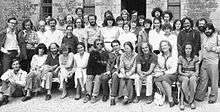Nouveau roman
The Nouveau Roman (French pronunciation: [nuvo ʁɔmɑ̃], new novel) is a type of 1950s French novel that diverged from classical literary genres. Émile Henriot coined the term in an article in the popular French newspaper Le Monde on May 22, 1957[1] to describe certain writers who experimented with style in each novel, creating an essentially new style each time. Most of the founding authors were published by Les Éditions de Minuit with the strong support of Jérôme Lindon.
| French literature |
|---|
| by category |
| French literary history |
| French writers |
|
| Portals |
|
Overview
Alain Robbe-Grillet, an influential theorist as well as writer of the Nouveau Roman, published a series of essays on the nature and future of the novel which were later collected in Pour un Nouveau Roman. Rejecting many of the established features of the novel to date, Robbe-Grillet regarded many earlier novelists as old-fashioned in their focus on plot, action, narrative, ideas, and character. Instead, he put forward a theory of the novel as focused on objects: the ideal nouveau roman would be an individual version and vision of things, subordinating plot and character to the details of the world rather than enlisting the world in their service.[2]
Despite the assertions of nouveauté, this vision of the novel can be construed as developing from earlier writers' suggestions and practice. Joris-Karl Huysmans, ninety years before, had suggested how the novel might be depersonalised; more recently, Franz Kafka had shown that conventional methods of depicting character were not essential; James Joyce had done the same for plot; and absurdist writers had engaged with some of the themes that preoccupied writers of the nouveau roman.
_-_Philippe_Binant_Archives.jpg)

A group of writers dubbed Nouveaux Romanciers, New novelists, appeared in the mid-1950s: Alain Robbe-Grillet, Claude Simon, Nathalie Sarraute, Michel Butor and Robert Pinget. The style had different approaches but generally rejected the traditional use of chronology, plot and character in fiction, as well as the omniscient narrator. The Nouveau Roman authors were open to influences from writers such as William Faulkner and the cinema. Both Robbe-Grillet and Marguerite Duras, whose 1958 novel Moderato cantabile was in the style of the Nouveau roman, also contributed to the French New Wave style of filmmaking.[3]
Alain Robbe-Grillet became an elected member of the Académie française on 25 March 2004, succeeding Maurice Rheims at seat No. 32. Claude Simon, the 1985 Nobel Laureate in Literature, is often identified with the nouveau roman movement. Jean Ricardou is the theorist of the nouveau roman literary movement.[4]
Authors in the style of the Nouveau Roman
Other writers associated with the style of Nouveau Roman are:
The Nouveau Roman and the Left Bank
The Nouveau Roman style also left its mark on the screen as writers Marguerite Duras and Alain Robbe-Grillet became involved with the Left Bank film movement (often labelled as part of the French New Wave). Their collaboration with director Alain Resnais resulted in critical successes such as Hiroshima mon amour (1958) and Last Year in Marienbad (1961). They would later go on to direct their own films.[5] Influenced by these films French courses in North America during the 1960s and 1970s often included works by Nouveau Roman authors such as Alain Robbe-Grillet's La Jalousie (1957), Michel Butor's La Modification (1957), Nathalie Sarraute's Le Planetarium (1957) and Marguerite Duras' Moderato Cantabile (1958).
The Nouveau Roman in Quebec, Canada
The Nouveau Roman influenced French-language writers in Quebec such as Jacques Godbout and Gerard Bessette. The Canadian-born French writer Nancy Huston declared that she began writing in direct reaction to the stark style of the Nouveau Roman in Nord Perdu (1999). (See Joseph Pivato, nouveau roman)
See also
- French literature
- Francophone literature
- List of French language authors
- Antinovel
References
- Émile Henriot (May 1957). "LA JALOUSIE, d'Alain Robbe-Grillet TROPISMES, de Nathalie Sarraute". Le Monde.
- Robbe-Grillet, Alain (1965). "A Future for the Novel". For a New Novel: Essays on Fiction. New York, NY: Grove Press, Inc. pp. 21–24.
- French literature - Toward the nouveau roman Encyclopedia Britannica
- Sirvent, Michel (2001). Jean Ricardou. De Tel Quel au Nouveau Roman textuel. Rodopi. ISBN 978-90-420-1591-3.
- Clouzot, Claire, Le cinéma français depuis la nouvelle vague, Fernand Nathan/Alliance Française, 1972
Bibliography
- Bernard Luscans, La représentation dans le nouveau nouveau roman, Chapel Hill, Université de Caroline du Nord, 2008.
- Joseph Pivato, 'Nouveau Roman Canadien', Canadian Literature 58 (Autumn 1973) 51-60. [canlit.ca/article/nouveau-roman-canadien/]
- Joseph Pivato, 'Nancy Huston Meets le Nouveau Roman, Athabasca University Canadian Writers Site. [canadian-writers.athabascau.ca/english/writers/nhuston/nouveau_roman.php.php]
